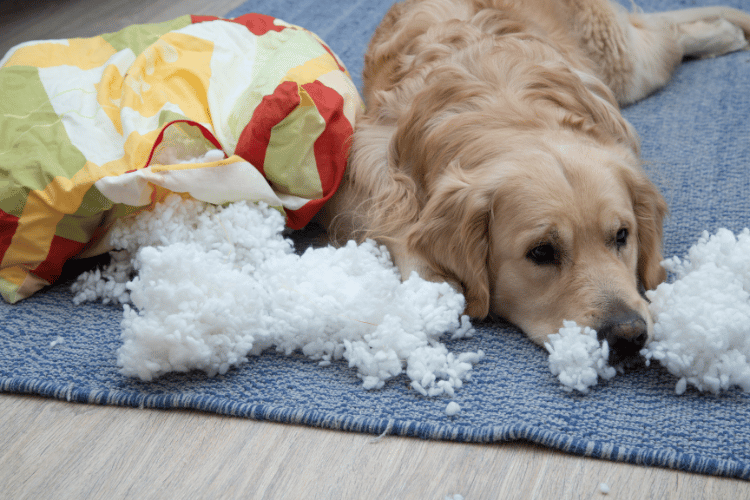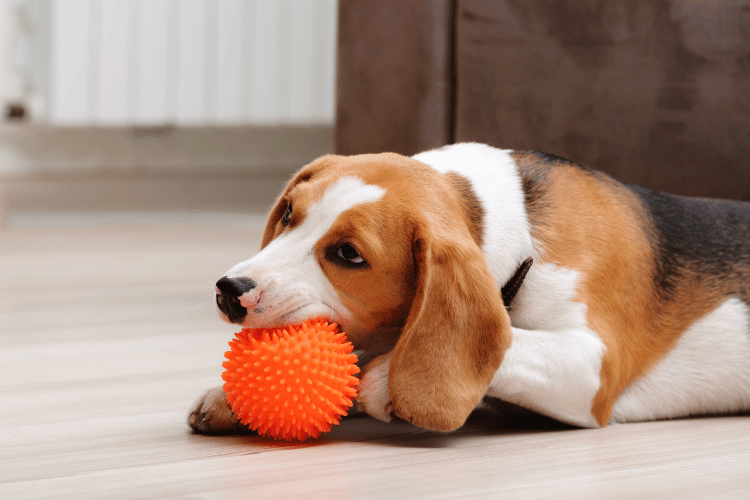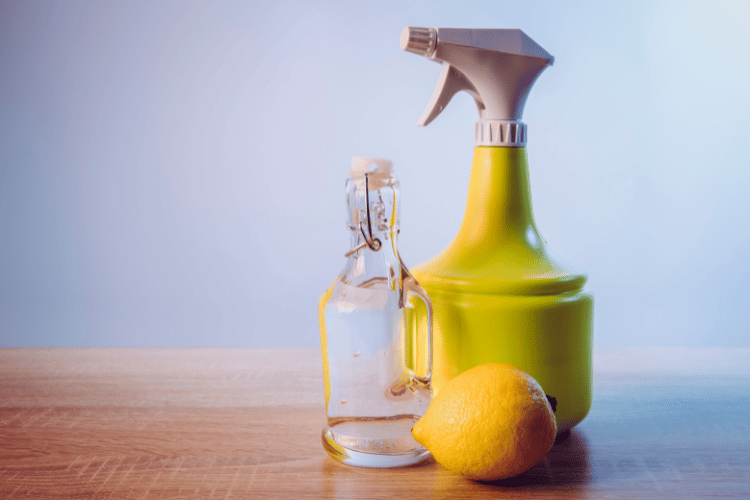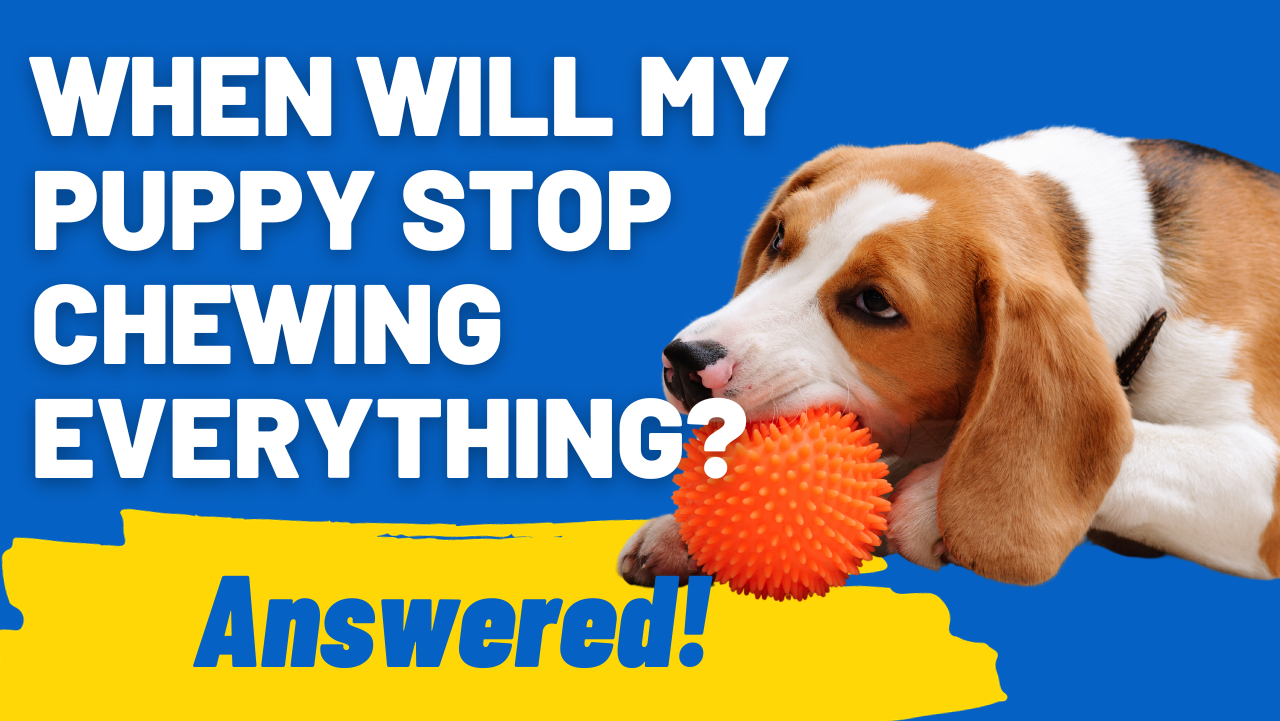You come back from work, and as you open the door, you’re met with a messy crime scene of chewed toilet paper, socks, and shoes. You notice a trail of the chewed toilet paper and follow it until you reach the culprit, adorably still having at it.
At this point, you can’t bring yourself to reprimand your lovable furry friend. They’re still a puppy, and they don’t know any better. You wonder, “When will my puppy stop chewing everything?”
Well, it primarily comes down to proper training using positive reinforcements and distinguishing between “good” and “bad” chewing items. Stick around to learn more about controlling your puppy’s destructive chewing behavior.
Do Puppies Grow Out Of Destructive Chewing?
Unlike us, puppies aren’t able to distinguish between bad and good behavior. If you don’t teach them at an early age that chewing on your remote control is considered a no-no, they’ll continue doing it.
Consequently, they don’t always grow out of chewing. If you don’t address the destructive behavior during their puppyhood, it can become a habit, and more challenging to train them to avoid chewing as they grow older.
Now, that doesn’t necessarily mean you have to train your pet to avoid chewing altogether. The action is critical to a dog’s health since it provides mental stimulation, releasing endorphins and increasing their sense of well-being.
For this reason, you’ll want to train your pet to differentiate between a chew toy and your belongings and household items.
How Do I Get My Puppy To Stop Chewing And Eating Everything?

While puppies love exploring everything with their teeth, it can lead to future issues. They could accidentally eat dangerous items, leading to poisoning or blockages. Their desire to consume non-food objects is called pica.
They can eat dirt, toys, or other heavily scented items. Your job is to first create a safe environment where these items aren’t near your puppy. Check out other tips to keep your pup from their pica tendencies.
Supervision
Keeping a close eye on your fur baby is crucial when preventing unwanted behavior. Now, if you can’t always be there to monitor the puppy, we recommend resorting to crate training.
Allowing them to stay in the crate gives you more control over getting rid of their chewing habits. Otherwise, you’ll want to ensure that these items below are out of reach:
- Cables and lead
- Potted plants
- Small objects and toys
- Rugs
- Bins
In addition, make sure that your bathroom doors are shut because they’re usually curious enough to take a sip from your toilet bowl.
Positive Reinforcement
To effectively nail down your positive reinforcement training, teaching your dog the “leave it” command is essential. It involves giving the pup a treat after following your order and not touching the “wrong” item.
As your training progresses, you can give them a treat whenever they’ve avoided inappropriate items they used to regularly pick up on the street.
Now, in the initial stages of puppyhood, your pet may hold the item in their mouth. In this case, teaching them the “drop it” command will prove highly useful.
You can even use the same technique when playing fetch or tug of war. These positive reinforcement training procedures need consistency to work in the long run and as your pup grows. Otherwise, the puppy can easily forget their training and continue eating everything they can sink their baby teeth on.
How Long Does Puppy Chewing Everything Last?
Your puppy will likely undergo two separate chewing phases. The first occurs during their teething phase.
Once your puppy grows out their adult teeth by five to six months of age, that chewing phase ends. That means you need to address the destructive chewing once they surpass that age.
After their teething phase ends, the puppy will go through their development stage lasting anywhere between seven and eight months. It can even be prolonged to two years.
During that phase, your pup’s chewing likely becomes driven by boredom. If you don’t give them a form of distraction or entertainment, they’ll continue to help themselves to your sock drawer.
How Do I Stop My Puppy From Destructive Chewing?
The first step to stopping the destructive chewing involves identifying the problem. It could be your pet going through their teething phase, which is normal puppy behavior. In other cases, they want to explore all the enticing items around them.
If the excessive chewing persists into late adulthood, you’ll want to examine mental issues, like separation anxiety, stress, or frustration. They might be going to town on your favorite t-shirt to relieve their stress from being left alone.
Another, less common, reason could be hunger. If you’re restricting your pup’s calories, you’ll want to revise their diet.
You could also consider fabric-sucking, which occurs if your puppy was weaned too early. Dogs are usually weaned once they reach eight to ten weeks of age. Fabric-sucking might be the issue if you notice them licking and sucking on objects.
After identifying the chewing culprit, you can use the tips below to minimize the destructive behavior.
Find Appropriate Dog Toys

You can’t take away everything your puppy chews and leave them with nothing. Remember, chewing is normal behavior. It promotes dental hygiene and healthy physical and mental stimulation.
Subsequently, you need to provide your pet with items like rope toys, edible chews, or toy bones. While they’re chewing on these objects, you must supervise them.
Make sure the toys aren’t too tough on your puppy’s teeth to avoid chipping and fractures.
Exercise Them
If you’re not giving your puppy the right amount of physical stimulation through exercise, they’ll likely put all that excess energy toward chewing.
Your pup needs to be tired enough so it doesn’t use any remaining energy on your shoe. Each breed has its respective physical exercise requirements. For instance, an Australian Shepherd is bound to need more movement than a Pug or Bichon Frise.
Change Chew Toys
While chew toys are an exceptional method to divert your dog’s attention from your belongings and furniture, they can still get bored with them.
Rotating or swapping them will keep their interest. You can do so every week or so. We suggest purchasing bundle chew toys to keep a stock of them on the side.
Hold Their Attention
You might’ve bought a new squeaky toy, but your puppy seems more interested in your rug. Don’t go back to the pet shop just yet. Instead, play with the toy next to your puppy and act excited.
Your actions could divert their attention from the inappropriate item. Once you’ve captured their interest, get rid of what they were previously chewing on. You can teach them the “drop it” command using this “interrupt and divert” training technique.
Do Puppies Go Through a Destructive Stage?
Your puppy goes through a couple of distinctive chewing or destructive phases. The first comes during their teething stage when milk teeth fall out to create space for adult teeth. They typically chew on objects to relieve teething discomfort.
After six to seven months, your pup should have grown out all 42 of its permanent teeth. If they still excessively chew in this phase, you’ll need to start training them to avoid the destructive habit.
Does Vinegar Stop Dogs From Chewing?

Creating a vinegar and citrus oil spray solution can deter your puppy from chewing unwanted objects. You can spritz the liquid on your furniture, wardrobe area, and rug to keep your pup’s teeth to themselves.
While the bitter taste and smell of vinegar will discourage them from biting into dangerous items, you’ll still need to give the pup safe chewing alternatives to keep them entertained and happy.
Chewing Prevention: What You Shouldn’t Do
When training your puppy to minimize their chewing, there are some tactics you’ll want to avoid.
Avoid Punishment
Your initial reaction to seeing your dog chewing your belongings shouldn’t be met with anger or frustration. Scolding or punishing the pet won’t get you anywhere.
Puppies won’t be able to connect your punishment to an action they committed recently. The negative action can set your training back and hinder the bond you’re trying to form with your furry friend.
Instead, you’ll want to step up on puppy-proofing your home to prevent destructive chewing in the first place.
Don’t Use a Muzzle
Muzzles are only meant to be worn temporarily during walks or vet visits. Forcing a muzzle on your puppy for a longer time than necessary will only worsen their stress. Consequently, it’ll lead to more chewing.
Don’t Leave Your Puppy In a Crate for Too Long
If you keep your puppy in their crate for long periods, they’ll feel more anxious from the lack of free movement and human interaction.
No mental or physical stimulation during puppyhood is a critical mistake you must avoid. It’ll exacerbate their stress, leading to more destructive chewing in the long run.
Key Takeaways
When will your puppy stop chewing everything? In short, you first need to identify where the excessive chewing is coming from. If they’re teething, then it’s normal behavior. If the habit remains, you’ll need to train them on which items they can chew and which they should avoid.
Destructive chewing can also originate from other issues like not getting enough exercise and mental stimulation, separation anxiety, or stress.
Aside from that, training them on simple commands like “drop it” and “leave it” can make a world of difference. In addition, you should avoid common mistakes like reprimanding, punishing, or muzzling your puppy.




